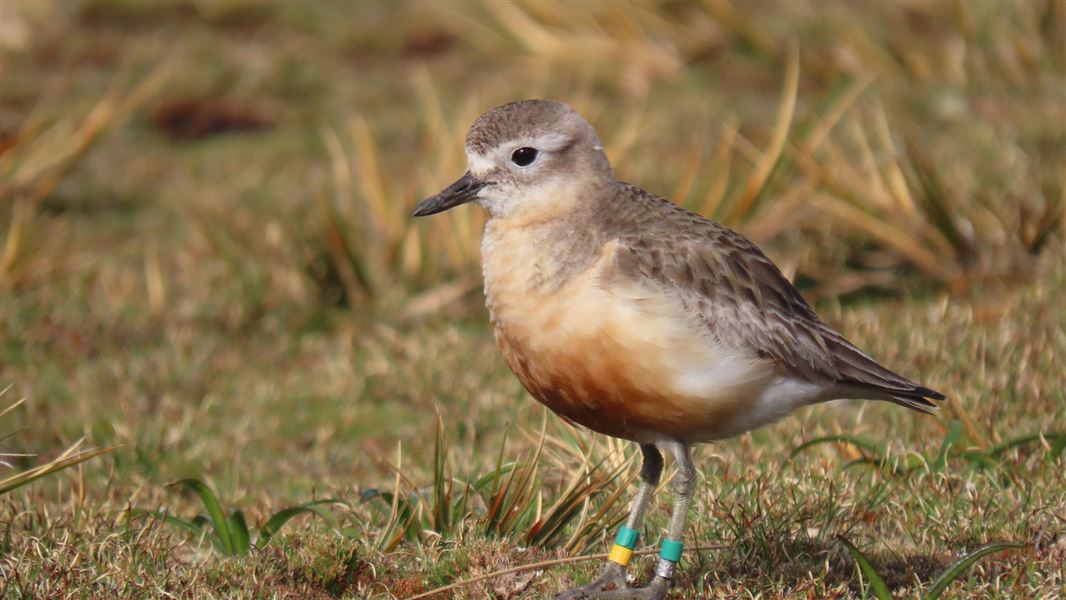Archived content: This media release was accurate on the date of publication.
Date: 16 May 2023
Annual flock counts of the Southern New Zealand dotterel, undertaken by DOC in April, estimate about 126 dotterels remain, a 13 percent decline from last years’ 144.
DOC Senior Ranger Kevin Carter says higher-than-average rat numbers, which in turn fuel higher numbers of feral cats, is thought to be one of the biggest contributing factors to the species’ decline.
“In 2022, Rakiura Stewart Island experienced a mast, or heavy fruiting event. More forest foods means more rats, and more rats means more feral cats - which spells bad news for vulnerable species like dotterels.
“Rats are the preferred prey for feral cats, however, when rat numbers drop off, feral cats look for alternative prey such as Southern New Zealand dotterel. We estimate between 40 to 50 dotterels died during the most recent breeding season. While most of the deaths were likely due to predation – disease, parasites and natural causes may have played a smaller part too.
“Fortunately, some of the adults were able to successfully breed and raise chicks to fledge, which softened the decline, meaning the population as a whole lost approximately 18 individuals.”
Southern New Zealand dotterels were once widespread throughout the South Island. They are a unique bird in that they breed on alpine mountain tops in summer before returning to coastlines and river mouth mudflats in the non-breeding season.
They have previously been recorded as high as 2,500 metres above sea level in the Southern Alps. Now their range is limited to the mountain tops of Rakiura for breeding, and Awarua Bay on the Southland Coast for foraging.
Due to ongoing predation pressures by feral cats, dotterels have spent the past few decades on the brink of extinction. In 1992, the population reached an all-time low of 62 birds but bounced back to 290 birds in 2010. Since 2010 however, the population has declined by 58%.
In response, DOC has bolstered recovery efforts with the recent formation of a permanent Southern New Zealand dotterel recovery team. Four dedicated field staff are increasing feral cat control in dotterel breeding areas in preparation for the upcoming breeding season, from October until early January.
New trap lines are being installed this winter and predator control will now continue all year round, keeping predator numbers low.
Kevin says controlling feral cats, as well as white tailed deer, black backed gulls, spur winged plovers and harriers which are also known to threaten nesting birds, is key to reversing the decline.
“Southern New Zealand dotterels have a life expectancy of about 20 years. Sadly, current data shows around 80 percent will not make it past their fifth year.
“This is why programmes such as Predator Free Rakiura, which aims to remove possums, rats, feral cats and hedgehogs from the island are so important. Our trapping and predator control work can hold the line, but the long-term solution requires landscape scale change.”
Background information
The Southern New Zealand dotterel (SNZD) population is classified as ‘nationally critical’ by DOC. Each year, flock counts are conducted to estimate the number of birds that remain.
In April 2023, flock counts were undertaken over three days at Awarua Bay, Freshwater mudflats in Paterson Inlet, Mason Bay/Te Oneroa, The Neck, and Port Pegasus/Pikihatiti. Based on the counts, we estimate that there are 126 SNZDs remaining. This is a 13% population decline since April 2022, where 144 birds were recorded.
Unfortunately, SNZDs no longer breed on the South Island, largely due to predation by introduced species such as feral cats and stoats. Records suggest that SNZDs were also regularly shot in the South Island in the late 1800s.
The only place you can see a SNZD in the South Island in the present day is at Awarua Bay near the Tiwai Aluminium smelter. Awarua Bay is a key site where almost half the population feed and flock together for most of the year before returning to the mountain tops of Stewart Island/Rakiura to breed.
Differences between Southern and Northern NZ dotterels
Southern New Zealand dotterels are recognised in New Zealand as their own sub-species but are recognised by the IUCN (International Union for Conservation of Nature) as a separate species.
They differ from the Northern New Zealand dotterel in both behaviour and appearance. While Southern New Zealand dotterels breed on mountain tops, the Northern birds breed on beaches around the North Island coastline.
Southern birds are larger and darker in breeding colours than Northern birds. Southern birds also have a larger mid-toe which is believed to be used for better stability in the alpine environment.
There are estimated to be more than 2,500 Northern New Zealand dotterel (Conservation Status = recovering).
Contact
For media enquiries contact:
Email: media@doc.govt.nz
